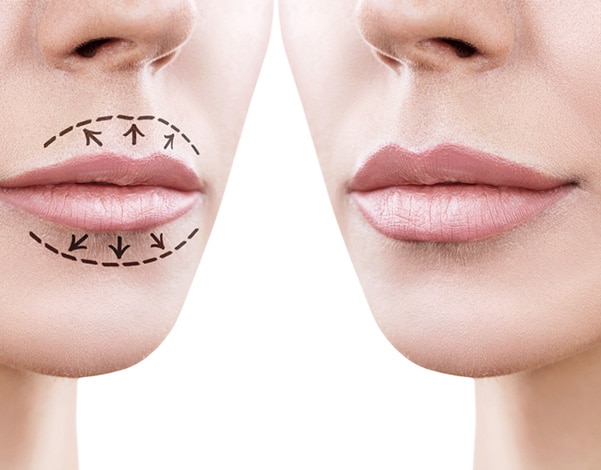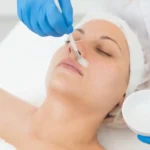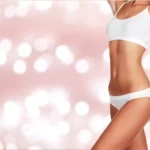
History of lip aesthetics
Lips aesthetics change through the years, with various features and forms favoured by different cultures during different eras for reasons related to cultural beliefs, courtship and social status, and beauty and aesthetic ideals. For example, a study conducted that examined Caucasian fashion models in the late 20th century showed fuller and more anteriorly positioned lips are considered more attractive. Additionally, a study examining changes in the profile of the male model from 1930 for 65 years found significant changes in the appearance of the ideal lip, including an enhanced lip protrusion, increased lip curl and an increase in vermilion display. The desire to achieve this aesthetic ideal, coupled with the increasingly accessible treatments available, have led to a dramatic rise of lip augmentation procedures. In fact, lip augmentation is one the most popular types of aesthetic procedures in demand since the advent of modern dermal fillers.
The “ideal” lip
While the standards that constitute the ideal lip varies by culture and era (for instance, Western culture tends to favour plump and well-defined lips, there are certain common features that should be considered, including fullness and volume, correct proportion between upper and lower lips, and a well-defined vermilion border.
In addition to the above, the lips should also be aesthetically harmonious and in proportion with the rest of the face. Sexual dimorphism must also be consideredmen have larger mouth widths, total lip height, lip volumes and philtrum widths than women. As mentioned previously, the aesthetic industry has experienced advances in technology that has resulted in a boom in the number of temporary, semi-permanent and permanent implants and fillers. However, with the increase in available treatments, practitioners should also be expected to be up-to-date with the current knowledge of lip anatomy, terminology, assessment and aesthetics in order to fully utilize these products and techniques successfully.
Lip anatomy
The lips cover the entrance to the oral cavity, and serve to influence mastication and phonation, as well as affect facial expression to facilitate nonverbal language. The upper lip extends from the base of the nose superiorly to the free edge of the vermilion border interiorly and to the nasolabial folds laterally. Hallmarks of the upper lip include the philtrum (a vertical groove in the middle area of the upper lip) and its pillars. The upper lip takes the shape of a “flattened M” in this area, commonly referred to as “Cupid’s Bow”. The vermilion is the red portion of the lip and consists of a “dry” and “wet” section. It is demarcated from the surrounding skin by the vermillion border, a rim of paler skin. The upper and lower lips join together at the oral commissures which form the corners of the mouth.
Assessing lips
The patient should be examined in their natural sitting position, in order to assess the lips in an upright manner. The lips should also be examined while they are relaxed and when they are in motion. This is to assess the natural position of the lips, as well as symmetry of muscle movement, and to check for action and hyperactivity of muscle groups. All of these aspects will be discussed further in the following sections. Lip position will be affected by changes in the positioning of the teeth and alveolar, both of which tends to increase in retrusion relative to the chin and bony facial plane with age. However, it is important to keep in mind that the lips should only be one element in what makes a smile attractive. Some of the other factors that determine the lower face and smile aesthetic include skeletal components, like the position of the jawbone relative to the maxilla; soft tissue factors such as the prominence of the chin and nose, as well as lip and soft tissue morphology; and factors related to the dentitions, gingivae and alveolar bone, such as crown length and width, incisor crown angulation, the incisal plane, the midline, gingival margin, open gingival embrasure, and gingiva-to-lip distance.
Clinical evaluation
Lip assessment is best performed methodically for optimal treatment outcomes. An example of a systematic lip evaluation includes assessing the following parameters:
• Lip height: The characteristics that should be measured in order to assess lip height include the upper and lower lips, lower lip/chin height, ratio of upper lip to lower lip/chin height, interlabial gap (the gaps between the lips at rest), and the upper and lower lip vermilion height.
• Lip thickness: An important consideration when assessing the lips as it is directly affects lips prominence and is influenced by ethnic background. Thinner lips are more capable of following the teeth and jaw movements, which makes any loss of movement or other aesthetic effects more apparent.
• Lip contour: The contour should be assess in both front and side views to evaluate the curvature, curl and inclination of the lip. The lips curl is affected by the position and strength of dentoskeletal support of the lips. One such instance is the occurrence of a flat upper lip due to maxillary dentoalveolar retrusion.
• Lip posture: The posture of the lip should be evaluated when the lips are at rest (relaxed with normal muscle tone), in a natural head position in repose. Also assess lip seal (ability of the lips to close) at this point. In certain cases, lip seal is not achieved when the lips are at rest, due to particular characteristics of the lip posture, and adaptive postures are used instead. In these cases, the patient is undergoing continuous contraction of circumoral musculature.
• Lip inclination: As mentioned before, support of the lips is dentoalveolar. Thus, the structure of the underlying bone and teeth will greatly influence how the lips will look. This is particularly pertinent when it comes to lip inclination, where protrusion or retrusion of the upper and lower incisors will change the inclination of the lips accordingly. For instance, impingement of the upper incisor teeth onto the lower teeth can result in eversion of the lower lip.
• Lip prominence: From the side, assess the prominence of the lips in relation to the prominence of the nose and chin. Lip prominence will vary according to skeletal factors, soft tissue factors such as lip thickness, or dentoalveolar factors such as position of the incisor teeth.
• Lip activity and function: Lip activity is assessed in terms of hyper- (high activity or overactivity) or hypo- (underactive, or low muscle toned, lips) tonic lips. Hypotonic lips appear flaccid and may be overstretched to attain lip seal. This feature is typical in individuals with an increased lower-face height. Hypertonic lips, on the other hand, may retrocline the lower incisor teeth (in the case of a hypertonic lower lip), or result in a gummy smile (due to a highly toned upper lip levator muscle).
Conclusion
The importance of the practitioner’s knowledge and understanding of the aging lip and perioral region cannot be overstated when it comes to the aesthetic treatment of lips. The patient should also be made fully aware of the considerations that go into treating the lips. In doing so, successful and satisfactory treatment results can be achieved.
Aesthetic medicine products are developed and regulated to meet stringent safety and efficacy standards. They are typically administered by trained healthcare professionals such as dermatologists, plastic surgeons, and specialized nurses in clinical settings. These products aim to provide effective solutions for cosmetic enhancement, skin rejuvenation, and overall aesthetic improvement, contributing to both physical appearance and self-confidence.
Key categories of aesthetic medicine products include:
-
Injectables: This category includes products such as dermal fillers, botulinum toxins (e.g., Botox), and collagen stimulators. These injectables are used to smooth wrinkles, add volume, and improve facial contours.
-
Skin Rejuvenation Treatments: Products like chemical peels, microdermabrasion systems, and laser devices are used to improve skin texture, reduce pigmentation irregularities, and enhance overall skin tone.
-
Skincare Products: These include medical-grade cleansers, moisturizers, serums, and topical treatments containing active ingredients like retinoids, antioxidants, and growth factors. They are formulated to address specific skin concerns such as acne, aging, and hyperpigmentation.
-
Hair Restoration Products: Medical treatments and products designed to promote hair growth and treat conditions such as male and female pattern baldness.
-
Body Contouring and Fat Reduction: Devices and products used for non-surgical body sculpting, such as cryolipolysis (cool sculpting) devices and injectable lipolytics.
-
Cosmeceuticals: High-performance skincare products that bridge the gap between cosmetics and pharmaceuticals, often containing potent ingredients with proven clinical benefits.
-
Wound Care and Scar Management: Products like silicone sheets, gels, and advanced wound dressings used to improve healing and reduce the appearance of scars.





